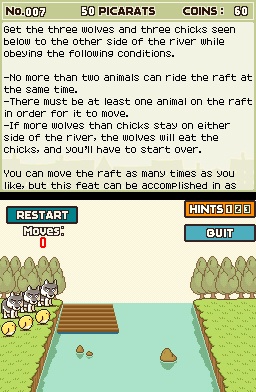Professor Layton Post-Release Q&A
Have you solved the mystery of the golden apple? Find out where our intrepid Layton is going from here in this interview with Level 5's president.
We'll admit we were among the most skeptical of the Nintendo DS's quirky feature set when Nintendo announced the handheld back in 2004. But with talented development studios such as Level 5 making smart and creative use of the DS's touch screen, microphone, and other capabilities, we needn't have worried. The company recently graced American gamers with Professor Layton and the Curious Village, one of its most charming and unique games yet. To find out more about the development of Layton, and where the franchise will go from here, we went straight to Level 5 president Akihiro Hino.
GameSpot: What spawned the ideas that birthed Professor Layton's story, setting, and gameplay? What was your inspiration for the title?
AH: The whole Layton series was born from a plan we had to turn Professor Akira Tago's series of best-selling books, Head Gymnastics, into a game. The original books were collections of puzzles and brainteasers that were popular with a wide range of readers, from the very young to the very old.

The thing was, right around that time, puzzle/brain games skyrocketed in popularity and a surge of titles in this genre hit the market. It was then that I decided that I wanted to create a game that did things a little differently, and I set out to produce a game that fused both story and puzzle-based game elements to create a genre we call "puzzle adventure." The Professor Layton series was born out of this endeavor.
GS: The game's setting exudes an atmosphere of old-world European charm. What steps did the team take to bring that atmosphere into being?
AH: As the plot is a sort of detective story, I decided to make London, the famous stomping grounds of Sherlock Holmes, the home of Professor Layton. Next we set about researching the kind of beautiful classic architecture and layout of European towns and countryside to create an environment befitting a British gentleman. We also paid special attention to the coloring scheme during production to give the game a sort of familiar, aged atmosphere.
GS: Can you describe the public response to the Layton series in Japan? We know that a sequel has already hit the market overseas. Do you have any plans to bring the rest of the series to American shores?
AH: Professor Layton has been a big hit in Japan, with sales figures for the series totaling some 1,700,000 units. The games are especially popular with young women, but Professor Layton is rapidly growing into a series well loved by people of all ages--we're even starting a manga for children. I hope the series gains a similar standing in the American market and is enjoyed by a wide range of users, from children to adults. With the introduction of the second and third games, I hope Professor Layton will grow into a popular franchise that people will have fun with and remember fondly for a long time. That would make me very happy.
GS: The first Professor Layton game was released in Japan over a year ago. Why did it take such a long time to bring the game to North America? Can we expect the sequel to take as long to make it here?
AH: Professor Layton was our first self-published title (in Japan) and the first title where we really had to think about how to develop the title overseas. I believe these factors had a lot to do with why things took so long. As for the sequel, I can't really say anything definite yet, but I hope everyone is excited about the series, and I would like to get the sequel over to America quickly.
GS: Nintendo has said that the American version of Professor Layton contains a number of new puzzles. What kind of puzzles are these exactly? Also, what sort of puzzles, if any, were removed from the list when making the American version?

AH: Some of the puzzles in the game rely heavily on knowledge of certain cultural practices or use wordplay to guide you towards the answer. As there are several differences in both language and culture between America and Japan, we adjusted the content by removing puzzles that worked only for the Japanese audience and implementing new puzzles in the American version to take their place.
GS: Tell us about the weekly puzzles available through the Nintendo Wi-Fi Connection. Will these puzzles be offered for free? How long will this service continue for?
AH: The response to the weekly puzzle download service in Japan has been quite impressive, and a great number of users have been enjoying the feature. As in Japan, the service in America will be offered free of charge. Once in your possession, these puzzles are yours to play as many times as you like, just like the puzzles in the main portion of the game. I hope all the American players out there have lots of fun with these puzzles.
GS: Thanks for your time, Hino-san.
Got a news tip or want to contact us directly? Email news@gamespot.com
Join the conversation